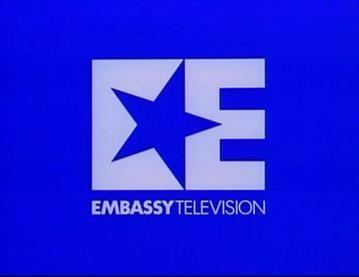Headquarters USA | Founded 1974 | |
 | ||
Type Joint venture of LEP Holdings, Inc. and PEP Communications. Active In-name-only unit of Sony Pictures Television Products Television ProductionBroadcast syndication Founders | ||
Elp communications columbia tristar television distribution short version 1987 1996
ELP Communications (formerly known as T.A.T. Communications Company, Embassy Television, Embassy Telecommunications, and Embassy Communications) was an American television production company that originally began in 1974. The company remains as an in-name only unit of Sony Pictures Television.
Contents
- Elp communications columbia tristar television distribution short version 1987 1996
- Beginning
- Acquisition of Avco Embassy and rename
- Coke era
- Columbia Pictures and Sony Pictures Entertainment eras
- Studios and tapings by ELP Communications
- Theatrical release
- In charge of production for Embassy Television
- References
Beginning
ELP Communications was first known as T.A.T. Communications Company when it was formed in 1974 when Norman Lear joined up with former talent agent Jerry Perenchio, a year before Yorkin ended his partnership with Lear. "T.A.T." stood for a Yiddish phrase pronounced "Tuches Ahfen Tisch", which meant "Putting one's butt on the line" (ass on the table).
The first sitcom to be produced by T.A.T. Communications was The Jeffersons, that was spun off from the groundbreaking sitcom All in the Family in 1975.
Acquisition of Avco Embassy and rename
Television producer Norman Lear and his business partner Jerry Perenchio bought Avco Embassy Pictures Corporation in January 1982 and decided to drop the name "Avco" from the name to bring back the name Embassy Pictures and T.A.T. Communications Co. was renamed to Embassy Communications, Inc.
Lear decided to launch Embassy Television, a division name for his shows by the former T.A.T. Communications such as The Jeffersons, One Day at a Time, and The Facts of Life. More shows were produced by Embassy Television such as the first two under the name: Square Pegs and Silver Spoons. The latter show ran five seasons, while the former ran one but developed a cult following. Who's the Boss? was piloted later in 1983 until airing in 1984. Embassy Television also produced Diff'rent Strokes's final season from Tandem Productions, which was eventually operated by Embassy.
Embassy also held the TV rights to a majority of the Embassy theatrical library (see Embassy Pictures for more information). Embassy Telecommunications (formerly P*I*T*S Films), was the television distribution arm of Embassy Television. They distributed off syndicated shows by Embassy Television and those by Tandem Productions and T.A.T. Communications.
Coke era
In 1985, CBS canceled The Jeffersons and NBC canceled Diff'rent Strokes, the latter of which then moved to ABC. Lear and Perenchio sold Embassy Communications (included Tandem Productions) to The Coca-Cola Company (then-current owners of Columbia Pictures) for $485 million on June 18 and a new sitcom, 227, debuted on NBC. After the sale, Lear, Perenchio, nor Bud Yorkin were no longer involved with Embassy or Tandem.
A year later, the television division was renamed to Embassy Communications as a full television production and distribution banner of Embassy by producing the shows by Embassy Television and distributing those by Tandem Productions and T.A.T. Communications. When ABC canceled Diff'rent Strokes, the brand name Tandem Productions was abandoned but renamed active as an in-name-only division. On November 24, 1986, Coca-Cola fused Embassy's television operations including the movie packages (Embassy II and Embassy III) with Columbia Pictures Television; the combined company became Columbia/Embassy Television, though Columbia and Embassy continued to produce and distribute programs under their separate names. During that formation, Coke took Columbia and Embassy out of the first-run syndication business and had them to focus on first-run network and off-net syndication programming. Married... with Children was the next successful sitcom by Embassy Communications in 1987.
Columbia Pictures and Sony Pictures Entertainment eras
On December 21, 1987, Coca-Cola sold its Columbia Pictures entertainment businesses to Tri-Star Pictures, Inc. and renamed the Tri-Star holding company as "Columbia Pictures Entertainment" for $3.1 billion. Still-running Embassy shows would bear the Columbia Pictures Television logo in January 1988 for the rest of their runs. Columbia/Embassy Television merged with Tri-Star Television to reform Columbia Pictures Television. Embassy Communications then became ELP (Embassy Limited Partnership) Communications the same time, but would have its name to appear in the credits by February 1988 under the banner of Columbia Pictures Television. On November 8, 1989, Columbia Pictures Entertainment was sold to Sony Corporation and renamed as Sony Pictures Entertainment on August 7, 1991.
The final surviving show to be produced by Embassy Television was Beakman's World in 1992. In February 1994, SPE merged Columbia Pictures Television and TriStar Television to become Columbia TriStar Television. All series by CPT, TriStar, ELP, and Merv Griffin were produced under the banner. Beakman's World was cancelled in 1997 and ELP Communications became an in-name only unit of Columbia TriStar Television in 1998.
Today, television distribution rights to both Embassy's television and theatrical libraries are now owned by Sony Pictures Entertainment's television division. Also, all shows from T.A.T. Communications Company to ELP Communications are all copyrighted by ELP Communications.
